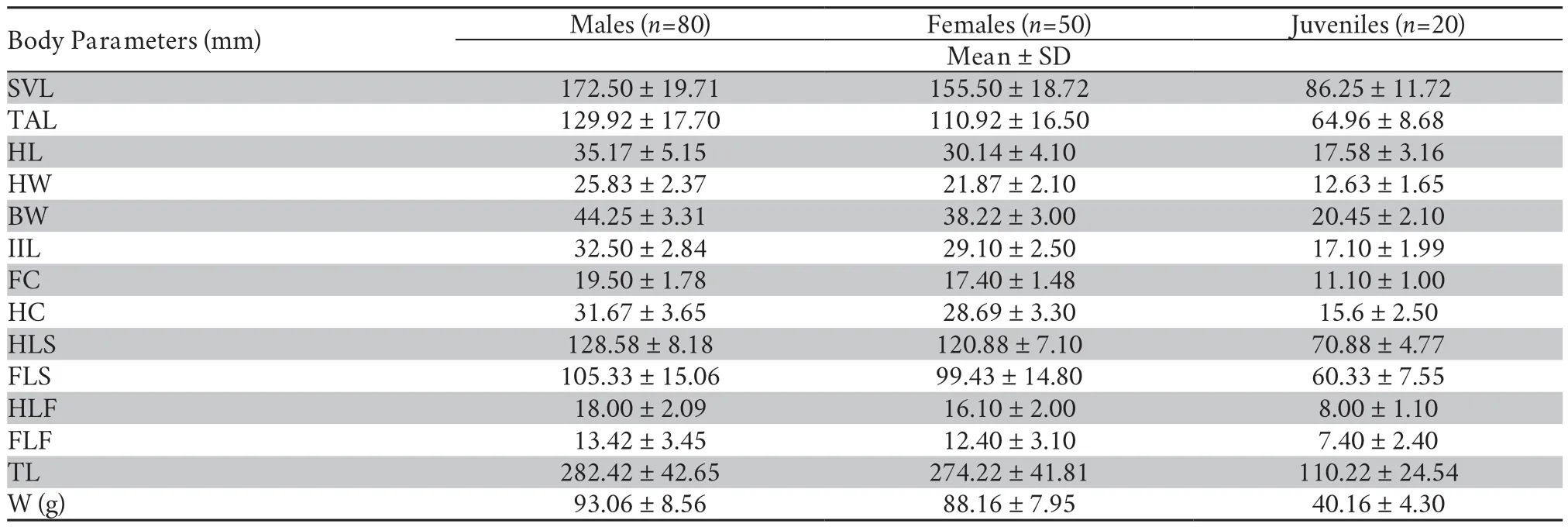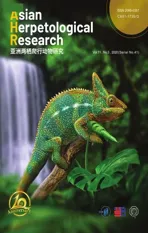Morphological Variations,Distribution and Population Estimation of Indian Spiny Tailed Lizard (Uromastyx hardwickii Gray,1827) from District Bahawalnagar,Punjab,Pakistan
2020-09-30WaqasALIArshadJAVIDSaddamHUSSAINAliHUSSAINandSyedMohsinBUKHARI
Waqas ALI,Arshad JAVID,Saddam HUSSAIN,Ali HUSSAIN and Syed Mohsin BUKHARI
Department of Wildlife and Ecology,University of Veterinary and Animal Sciences,Lahore,Pakistan
Abstract This study was conducted in selected sites of District Bahawalnagar namely,Shaheed Chowk,Chak40/F,Chak 163/7R and Fareedkot Tiba between March 2019 and August 2019.Sampling techniques included recording of burrows,flooding,burrow exaction,noose traps and pit fall traps were used to capture Uromastyx hardwickii.During this survey 150 individuals were captured from study area for morphological measurement and population estimation.The average snout to vent length (SVL) of male,female and juveniles were (172.50 ± 19.71) mm,(155.50 ± 18.72)mm and (86.25 ± 11.72) mm respectively.The average weight of male,female and juvenile was (93.06 ± 8.56)g,(88.16 ± 7.95) g and (40.16 ± 4.30) g respectively.The relative abundance (Pi) of males,females and juveniles were 0.53,0.33 and 0.13.Indian spiny tailed lizard (U.hardwickii) has been listed in the IUCN Red list and CITES.Major threats to the species in the study area are increase in urbanization,habitat fragmentation,illegal hunting for meat and fat.In this regard strict implementation of the Wildlife act is needed to protect the wildlife of Punjab.Furthermore,comprehensive surveys are required in throughout Punjab to declare conservation status of U.hardwickii.
Keywords habitat,morphological characters,population,Uromastyx hardwickii.
1.Introduction
The reptiles are mostly cosmopolitan in distribution except some isolated islands and poles (Aliet al.,2018).The distribution of reptiles is directly linked with geographic position and climate of any country.Reptiles are important member of food chain and play significant role in maintaining healthy ecosystems.Anthropogenic activities are depleting their population day by day(Petrov,2004).
Conservation education and knowledge among the local community is essential to identify and point out values of reptiles they provided to nature and human being.1895 (30%) reptiles out of 6285 species are globally threatened (IUCN,2009).It is very difficult to exactly assess which portion of herptiles populations are experiencing decline.In this regard,base line surveys at regional level are needed to review herptiles conservation status (Aliet al.,2018).
Many anthropogenic activities such as construction of building,deforestation,fires,use of pesticides,deep tilling and global warming are destroying and changing habitat of many reptiles species (Beckeret al.,2007).The change in the habitat threatened many populations of herpetiles through genetic drift and inbreeding causing extinction of many species (Gaineset al.,1997).Although,many studies have been conducted to explore amphibian and reptiles in Pakistan,most of the surveys are restricted to Sindh and Baluchistan Provinces (Aliet al.,2016).Recently,Uromastyx hardwickiihas been reported from Kalabagh Game Reserve,Mianwali Punjab,Pakistan (Aliet al.,2017).Keeping in view of above-mentioned factors the present survey was planned to explore the distribution pattern and population estimation ofU.hardwickiifrom district Bahawalnagar,Punjab,Pakistan.
The core objectives of present survey were 1) To check the morphological variation inU.hardwickiicaptured from study area.2) To check the current distribution ofU.hardwickiiin the study area.3) Population estimation ofU.hardwickiiin the study area.
2.Materials and Methods
2.1.Study areaThe present survey was conducted at four sub-sampling sites of district Bahawalangar,Punjab Pakistan namely Shaheed Chowk,Chak 40/F,Chak 163/7R and Fareedkot Tiba (Table 1).The district Bahawalnagar (30° 00’N,73° 15′ E) is situated in south of Punjab province.The district Bahawalnagar is covered by Indian boarder from east and south sides,Bahawalpur district on west and river Sutlej flows on its northern side.The total area of district Bahawalnagar is 8878 km2.Thefour sub sampling siteswere observed for theU.hardwickiipopulation in the study area. Vegetation of study area is generally sparse,consisting of xerophytes and halophyte shrubs and grasses but there are localized areas that represent green thick patches of shrubs ofCallotropis,ProsopisandArtemesia.The climate of the study area is an arid subtropical,continental type with low and random rainfall,high temperature,low relative humidity,high rate of evaporation and strong summer winds (Khan,2006).
2.2.Sampling techniquesFor the collection of specimens,the study area was divided into two different micro-habitats viz.uncultivated fields and desert areas (Figures 1,2,3 and 4). The following techniques have been used to estimate population ofU.hardwickiiin the study area:
2.2.1.Sightings of burrowsSightings of the active burrows are solid evidence for the presence ofU.hardwickiiin the study area.
2.2.2.Burrows estimationThe burrows were estimated by belt transect method applied in 10 km apart in the study area 100 m away from the road site to avoid the edge effect.Each belt was 80m × 20m area and applied in east and west directions.Two observers stood at 10m apart from belt and counted the active and inactive burrows (Figure 5). The time spend in each belt transect was 10 minutes.
2.2.3.Active capturingActive capturing techniques such as flooding the burrows with water and excavation of burrows have been used to capture the specimens.This technique is useful as burrows ofU.hardwickiiis a long single zigzag tunnel.
2.2.4.Passive capturingSpecimens were captured via noose traps and pit fall traps.Details viz.location,date,time,habitat,coloration,sex and morphometric measurements of each captured specimen was noted on the field proforma.

Figure 1 Habitat around Shaheed Chowk.

Figure 2 Habitat around Chak 40/F.

Figure 3 Habitat around Chak 163/7R.
A few specimens (n=5) were preserved in 75% alcohol and have been deposited in the Zoological Museum,University of Veterinary and Animal Sciences,Lahore for future molecular studies.
2.3.Morphometric MeasurementsMorphometric measurements were noted following Aliet al2017.SVL;measurement from tip of the snout to vent excluding tail,TAL:measurement from vent to tip of the tail,HL:from the back of the mandible to the tip of snout,HW:widest point of the head,BW:widest point of the mid body,IIL:area between fore limb and hind limb,FC:distance between the tip of finger to base of outer palm, HC:proximal edge of inner metatarsal tubercle to tip of longest toe,HLS:right finger distance to left hind claw,FLS:distance left fore claw to longest right finger, HLF:finger of hind limb to finger to bottom,FLF:measurement from tip of the longest finger to bottom of the finger of fore limb and W:measurement of the heaviness of specimen and TL:measurement from tip of the snout to tip of the tail (Figure 6).
2.4.Statistical analysisDiversity software PAST 3.0 was used to find out relative abundance ofU.hardwickiifrom study area.
3.Results
The study area was divided into two different micro-habitats viz.uncultivated fields which are mostly barren areas and desert area having no or seasonal water.Various active and passive techniques have been used to estimate population ofU.hardwickiifrom study area. During present field survey,a total 150 specimens of Indian spiny tailed lizard (U.hardwickii)were captured including 80 males,50 females and 20 juveniles(Table 2).The relative abundance (Pi) of males,females and juvenilesU.hardwickiiwas 0.53,0.33 and 0.13 respectively (Table 2).Figure 7 showing map of historic and current distribution ofU.hardwickiiin the study area.
The average snout to vent length (SVL) of maleU.hardwickiiwas (172.50 ± 19.71) mm,tail length (129.92 ± 17.70) mm,body width (44.25 ± 3.31) mm and total length (282.42 ± 42.65)mm.Average female snout to vent length,tail length,body width and total length was (155.50 ± 18.72) mm,(110.92 ± 16.50)mm,(38.22 ± 3.00) mm and (274.22 ± 41.81) mm,respectively.Similarly,the average juvenile snout to vent length,tail length,body width and total length was (86.25 ± 11.72) mm,(64.96 ± 8.68) mm,(20.45 ± 2.10) mm,and (110.22 ± 24.54) mm,respectively.The average weight of males,females and juvenile were (93.06 ± 8.56) g,(88.16 ± 7.95) g,and (40.16 ± 4.30) g,respectively (Table 3).
It was observed that burrows are open during the morning hours so the lizardemerge to feed and the burrows are closed using loose soil to prevent predators and to maintain internal temperature on hot days.

Figure 4 Habitat around Fareedkot Tiba.

Figure 5 Active burrow of Uromastyx hardwickii.

Figure 6 Morphology of Uromastyx hardwickii.
The burrows in the study area were mostly destroyed by human activities including grazing cattle and illegal hunters.The locals are mostly exploitingU.hardwickiifor its fat(Figure 8).

Table 3 Weight (g) and external body measurements (mm) of Uromastyx hardwickii captured from different habitat types of District Bahawalnagar.(SD is mentioned only when more than one specimen are recorded).
4.Discussion
Uromastyx hardwickii,theIndian spiny tailed lizard is extensively distributed in barren tracts of hard soil with moderate to sparse xerophytic vegetation,throughout the Indus valley. In Punjab it has been recorded throughout the southern districts of Punjab viz,Bahawalnagar to DG Khan and Mianwali districts to Cholistan desert of Rahim Yar Khan.Recently,U.hardwickiihas been reported from Kalabagh Game Reserve,Mianwali Punjab,Pakistan with relative abundance (Pi) of 0.03871 (Aliet al.,2017).
During this survey,it was observed thatU.hardwickiiused self-digging burrows and male-female sex ratio for one active burrow was 1:1.However hatchlings share the burrows with mother for 1-3 months.The speciesbreeds from March to August and remains inactive or hibernates in the winter season.
The burrows are a zigzag tunnel 2m long of Z or L shape having many chambers where 6-16 eggs are laid in a special side chamber.The juveniles are active during June (Parshad,1916; Minton,1966).The lizard are purely herbivore feeding on leaves,twigs,flowers,fruits,some time feed on insects,nymphs and locusts (Khan,2006).Coloration of lizards change with time; when emerging from the burrow they are olive gray and during basking become lighter gray or yellowish brown(Figures 9 and 10).Conservation status of herpetofauna has not been evaluated for Pakistan so far however,globallyU.hardwickiilisted as endangered species according to IUCN.

Figure 9 Uromastyx hardwickii (Light colour).

Figure 10 Uromastyx hardwickii (Dark colour).
5.Conclusion
Herpetological surveys in Pakistan are outdated.The only authentic source of information is data collected by Khan(2006).There is need to investigate reptile diversity of Punjab as most of the surveys are restricted to Sindh and Baluchistan Provinces.The population ofU.hardwickiiis declining in the study area due to illegal exploitation of the species for its fat and tail.In this regard strict implementation of wildlife act is need of time to protect wildlife of Punjab.Furthermore,comprehensive surveys are required throughout Punjab to review the conservation status ofthe species.
AcknowledgementI am thankful to Mr.Ghulam Mohayudin DIN,Lecturer in Department of Wildlife and Ecology,UVAS for digitizing distribution map.
杂志排行
Asian Herpetological Research的其它文章
- Effects of Dietary Protein Variations at Different Life-stages on Vocal Dominance of the African Clawed Frogs
- Tail Display Intensity is Restricted by Food Availability in an Asian Agamid Lizard (Phrynocephalus vlangalii)
- Flexibility as a Strategy for Avoiding Call Overlap in Male Anhui Treefrogs
- No Evidence for the Compensation Hypothesis in the Swelled Vent Frog(Feirana quadranus)
- Age and Body Size of the Shangcheng Stout Salamander Pachyhynobius shangchengensis (Caudata:Hynobiidae) from Southeastern China
- The Impact of Stream Landscape on Genetic Structure and Dispersal Patterns in Stream Salamander (Pachyhynobius shangchengensis)
